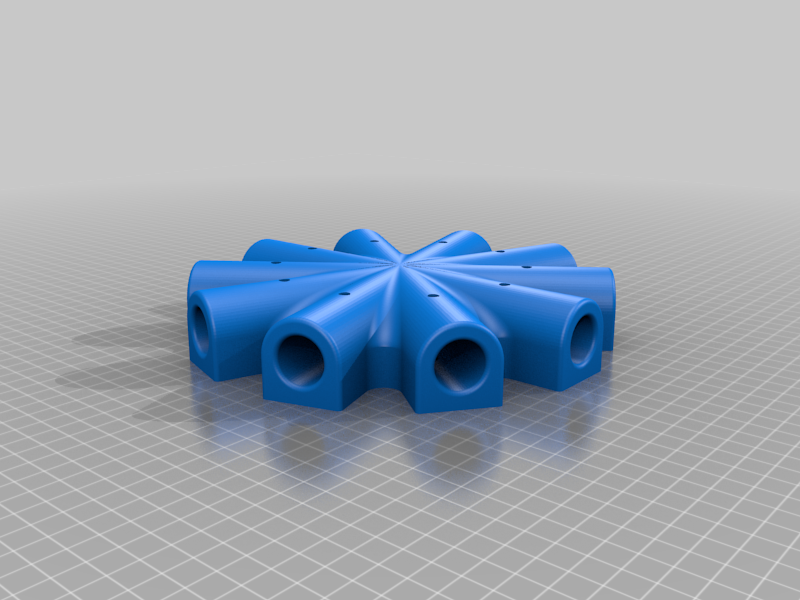
20mm Conduit 10-Way Connector
thingiverse
WARNING: DO NOT USE THIS FOR ELECTRICAL PURPOSES, THE BOLT HOLES (IF USED) WOULD GO THROUGH THE WIRES (AN OBVIOUS SAFETY ISSUE), THIS IS FOR GARDEN/OUTDOOR FRAME WORK PURPOSES ONLY. WHY 20MM CONDUIT? I use a lot of 20mm electrical conduit to support my frost covers, netting, and 2D/3D trellises. Some use them for hoop houses and green houses too. I like the 20mm conduit because it's very cheap, available everywhere, lasts for ages, is flexible, and yet, with the right structure... it's quite rigid. However, the connectors to create fanciful 2D/3D structures aren't available, and the commercial connectors are for electrical purposes only.. no where NEAR strong enough to handle the weight/stresses of bent conduit, particularly in windy locations. Also, 20mm conduit has one additional benefit. If combined with frost covering, you can use 50mm bulldog clips to attach/anchor the fabric, directly around the conduit, this further reinforces the frame too. WHY 10-WAY? This is the 10-socket connector, I actually built it with simple dome like trellises/netting/frost cover frames in mind. As fruit trees get bigger, a frame using 20mm conduit gets pretty... wobbly. So it needs more supports to form a honeycomb structure. Also, it's about as many sockets as I can fit on a standard FDM printer like an Ender3 or Prusa I3 series. If I add many more, the socket depth decreases, putting more pressure on less plastic... Why limit yourself to joints with 10 sockets? I've also created a whole series of connectors for 20mm conduit. Seriously, why be boring with rectangular frames and trellises? 1- Way "Stake styled" Anchor found here: https://www.thingiverse.com/thing:6228095 1-Way "Screw down" anchor found here: https://www.thingiverse.com/thing:6228135 2-Way "Straight" Connector: https://www.thingiverse.com/thing:6187349 2-Way "Right-Angle" Connector: https://www.thingiverse.com/thing:6188056 3-Way "T-connector" found here: https://www.thingiverse.com/thing:6163480 A 3 way, Y-connector found here: https://www.thingiverse.com/thing:6181085 A 4 way "cross" connector, found here: https://www.thingiverse.com/thing:6163584 A 5 way "star?" connector, found here: https://www.thingiverse.com/thing:6181104 A 6 way connector found here: https://www.thingiverse.com/thing:6181111 A 7 Way connector found here: https://www.thingiverse.com/thing:6187567 A 8 Way found here: https://www.thingiverse.com/thing:6167506 A Half 8-Way Connector: https://www.thingiverse.com/thing:6195584 Quarter 8-Way Connector: https://www.thingiverse.com/thing:6196723 A 9-Way found here: https://www.thingiverse.com/thing:6190630 WHY THE FLAT DESIGN? My design basis (for all of these connectors) has three things going for it: It can be easily printed without ANY supports whatsoever. It is FAR stronger than commercial connectors, and takes advantage of "laid flat" orientation to minimise the weaknesses involved in layered FDM printing) and if that isn't enough... I included M4 bolt holes so you can simultaneously: a) Lock the conduit into the connector using the bolt. (Drill a hole through the conduit first, obviously) b) Use the M4 bolt, nut and washers to ensure the layers of the connector are held together, even under significant strain. Hand tight is enough, you don't want to crush the plastic. NOTES: While I don't recommend PLA for this purpose, (It's exposed to UV and water after all) I chose to use PETG and protect the conduit from UV by wrapping it in duct tape. It's working well so far, but we'll see how it's going after a couple of seasons.
With this file you will be able to print 20mm Conduit 10-Way Connector with your 3D printer. Click on the button and save the file on your computer to work, edit or customize your design. You can also find more 3D designs for printers on 20mm Conduit 10-Way Connector.
